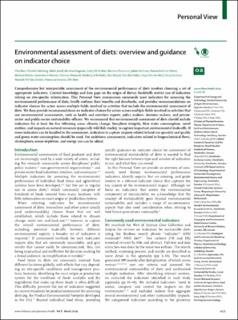Environmental assessment of diets: overview and guidance on indicator choice
| dc.contributor.author | Ran, Ylva | |
| dc.contributor.author | Cederberg, Christel | |
| dc.contributor.author | Jonell, Malin | |
| dc.contributor.author | Bergmann, Kristina | |
| dc.contributor.author | De Boer, Imke | |
| dc.contributor.author | Einarsson, Rasmus | |
| dc.contributor.author | Karlsson, Johan | |
| dc.contributor.author | Karlsson Potter, Hanna | |
| dc.contributor.author | Martin, Michael | |
| dc.contributor.author | Metson, Geneviève | |
| dc.contributor.author | Nemecek, Thomas | |
| dc.contributor.author | Nicholas, Kimberley | |
| dc.contributor.author | Strand, Åsa | |
| dc.contributor.author | Tidåker, Pernilla | |
| dc.contributor.author | van der Werf, Hayo | |
| dc.contributor.author | Vanham, Davy | |
| dc.contributor.author | van Zanten, Hannah H. E. | |
| dc.contributor.author | Verones, Francesca | |
| dc.contributor.author | Röös, Elin | |
| dc.date.accessioned | 2024-03-07T08:50:23Z | |
| dc.date.available | 2024-03-07T08:50:23Z | |
| dc.date.created | 2024-03-06T08:55:52Z | |
| dc.date.issued | 2024 | |
| dc.identifier.issn | 2542-5196 | |
| dc.identifier.uri | https://hdl.handle.net/11250/3121373 | |
| dc.description.abstract | Comprehensive but interpretable assessment of the environmental performance of diets involves choosing a set of appropriate indicators. Current knowledge and data gaps on the origin of dietary foodstuffs restrict use of indicators relying on site-specific information. This Personal View summarises commonly used indicators for assessing the environmental performance of diets, briefly outlines their benefits and drawbacks, and provides recommendations on indicator choices for actors across multiple fields involved in activities that include the environmental assessment of diets. We then provide recommendations on indicator choices for actors across multiple fields involved in activities that use environmental assessments, such as health and nutrition experts, policy makers, decision makers, and private-sector and public-sector sustainability officers. We recommend that environmental assessment of diets should include indicators for at least the five following areas: climate change, biosphere integrity, blue water consumption, novel entities, and impacts on natural resources (especially wild fish stocks), to capture important environmental trade-offs. If more indicators can be handled in the assessment, indicators to capture impacts related to land use quantity and quality and green water consumption should be used. For ambitious assessments, indicators related to biogeochemical flows, stratospheric ozone depletion, and energy use can be added. | en_US |
| dc.language.iso | eng | en_US |
| dc.publisher | Elsevier | en_US |
| dc.rights | Navngivelse 4.0 Internasjonal | * |
| dc.rights.uri | http://creativecommons.org/licenses/by/4.0/deed.no | * |
| dc.title | Environmental assessment of diets: overview and guidance on indicator choice | en_US |
| dc.title.alternative | Environmental assessment of diets: overview and guidance on indicator choice | en_US |
| dc.type | Peer reviewed | en_US |
| dc.type | Journal article | en_US |
| dc.description.version | publishedVersion | en_US |
| dc.source.journal | The Lancet Planetary Health | en_US |
| dc.identifier.cristin | 2252253 | |
| cristin.ispublished | true | |
| cristin.fulltext | original | |
| cristin.qualitycode | 1 |

